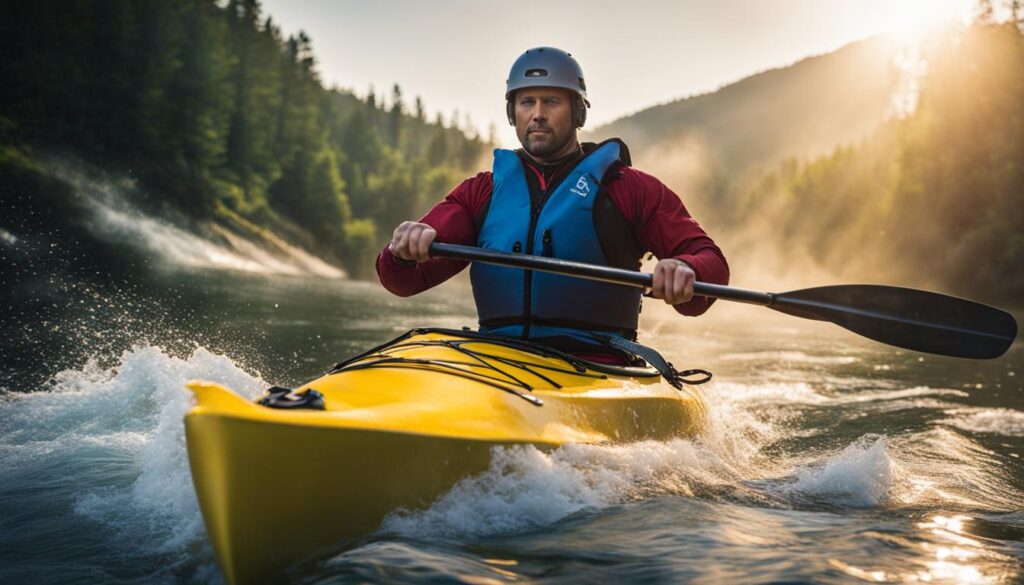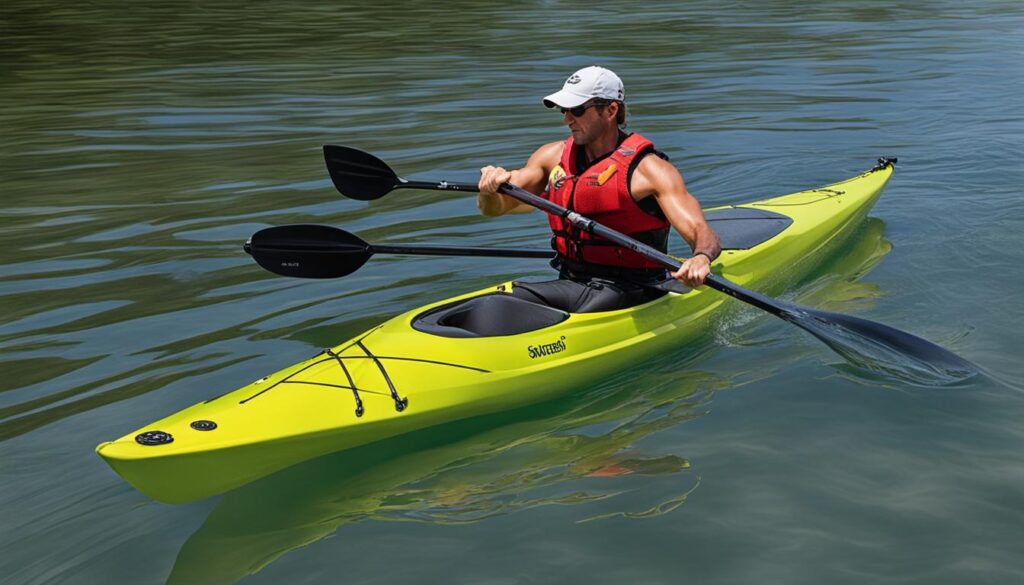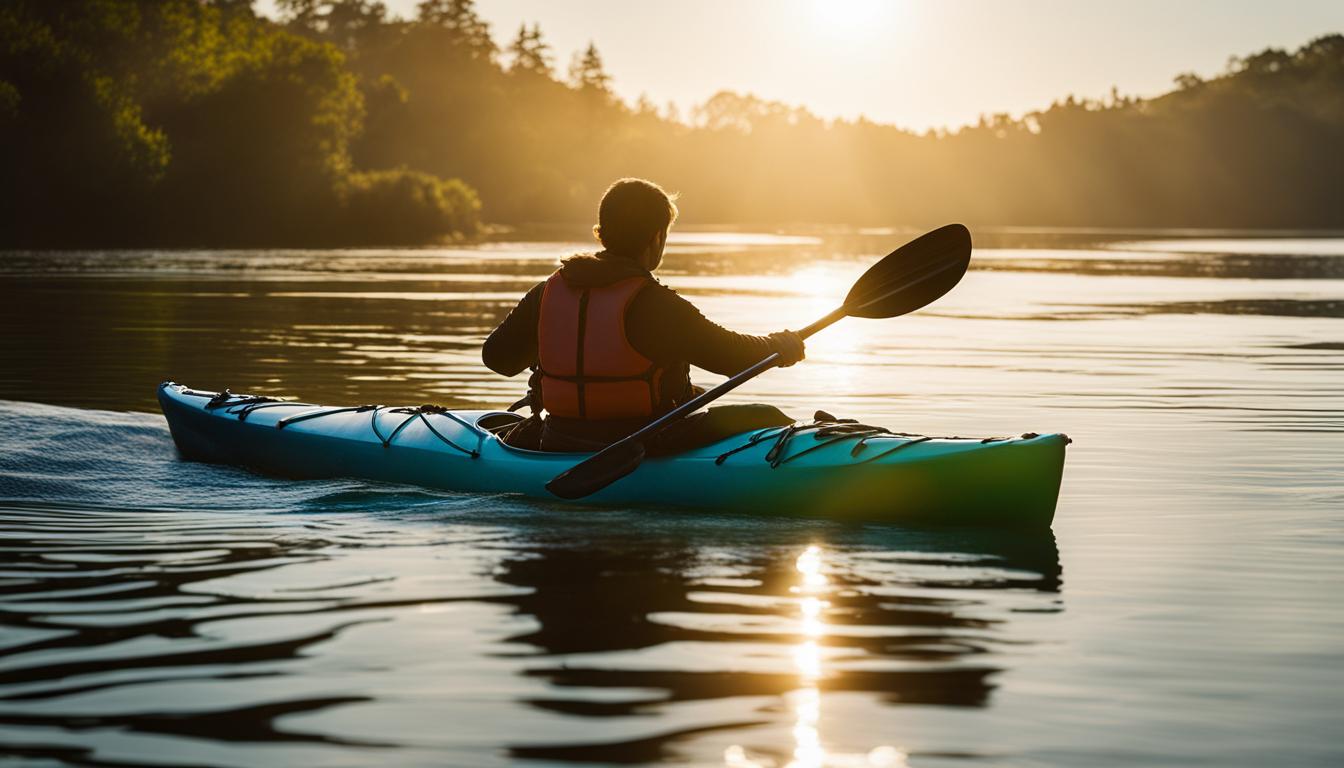Kayaking is an invigorating sport that offers adventure, tranquility, and a great physical workout. Whether you’re a beginner or an experienced paddler, there’s always room to improve your skills and unlock your full potential on the water. One of the key aspects of becoming a proficient kayaker is mastering various paddle techniques. These techniques not only ensure efficient kayaking but also enhance your overall kayak paddle skills.
In this comprehensive guide, we will delve into advanced kayaking techniques that will take your recreational kayak paddling to the next level. From efficient paddling techniques to methods of improving your overall kayak paddle skills, we will cover it all. By implementing these techniques, you’ll be able to navigate the waters with increased confidence, efficiency, and prowess.
Key Takeaways:
- Recreational kayak paddling offers adventure, tranquility, and a physical workout.
- Mastering paddle techniques is crucial for efficient kayaking.
- Improving your kayak paddle skills enhances your overall performance on the water.
- Implementing advanced techniques increases your confidence and prowess in kayaking.
- This guide will cover efficient paddling techniques and methods to improve your overall kayak paddle skills.
Understanding the Basics of Kayaking
Before you can dive into advanced kayaking techniques, it’s important to have a solid understanding of the basics. Whether you’re a beginner or looking to brush up on your skills, mastering the fundamental aspects of kayaking will set you up for success on the water.
Let’s start with the different types of kayaks. There are recreational kayaks, which are great for calm waters and leisure paddling. Touring kayaks are designed for longer trips and offer more storage space. Whitewater kayaks, on the other hand, are built to tackle fast-moving rivers and rapids. Understanding the purpose and characteristics of each kayak type will help you choose the right one for your needs.
Once you have the right kayak, it’s time to familiarize yourself with the necessary equipment. A proper fitting life jacket, or personal flotation device (PFD), is crucial for safety. You’ll also need a paddle that suits your height and paddling style. Don’t forget about essentials like a bilge pump, spray skirt, and dry bag to keep your belongings protected from water.
Now that you have the kayak and equipment sorted, it’s time to learn the basic paddle strokes. The forward stroke is the foundation of kayaking, propelling you forward efficiently. The backward stroke helps you slow down or reverse, while the sweep stroke allows for turning. These fundamental strokes form the building blocks for more advanced techniques, so it’s important to practice them until they become second nature.
Basic Kayak Strokes for Beginners
| Paddle Stroke | Description |
|---|---|
| Forward Stroke | The forward stroke is performed by reaching forward and inserting the paddle blade into the water near your toes. Pull the paddle blade back towards your hip, keeping it close to the kayak. Rotate your torso and repeat the motion on the other side. |
| Backward Stroke | The backward stroke is the reverse of the forward stroke. Start with the paddle near your hip and push it forward, away from the kayak. Continue the motion until the paddle blade reaches the front of the kayak. Repeat on the other side. |
| Sweep Stroke | The sweep stroke is used for turning the kayak. Place the paddle blade near your toes and sweep it outwards in an arc, away from the kayak. The stroke should end near the stern of the kayak. Repeat on the other side to turn in the opposite direction. |
In conclusion, understanding the basics of kayaking is essential for any paddler. By familiarizing yourself with different kayak types, obtaining the necessary equipment, and mastering basic paddle strokes, you’ll be well-prepared to embark on your kayaking adventures. So grab your paddle and get ready to explore the beauty of the water!
Importance of Physical Conditioning for Kayaking
When it comes to kayaking, having strong physical conditioning is essential. Developing your cardiovascular fitness will not only increase your endurance for longer kayaking trips, but it will also help you navigate rapid waters more effectively. Engaging in activities like running and swimming can improve your cardiovascular health and prepare your body for the demands of kayaking.
In addition to cardiovascular fitness, it’s important to strengthen your upper body and core muscles. These muscles play a crucial role in paddling power and stability. Incorporating exercises such as push-ups and planks into your fitness routine can help build strength in these areas, allowing you to generate more power with each stroke and maintain control of your kayak.
Flexibility is another key aspect of physical conditioning for kayaking. Stretching exercises and yoga can help improve your range of motion, allowing for more efficient paddle strokes. By increasing your flexibility, you’ll be able to engage the proper muscles and execute each stroke with precision, reducing the risk of strain or injury.
Ergonomic Paddling Methods
Mastering ergonomic paddling methods is crucial for both efficiency and injury prevention. It involves finding the optimal position for your body and making small adjustments to your technique to minimize strain and maximize power.
One important aspect of ergonomic paddling is ensuring your kayak is properly fitted to your body. Adjusting the footpegs, seat, and backrest to your preference can help maintain a natural and comfortable posture throughout your paddling session. This alignment will prevent excessive strain on your back, shoulders, and arms, allowing you to paddle with greater ease.
Another key element of ergonomic paddling is paying attention to your body mechanics. Focusing on using your core muscles, engaging your legs, and keeping your arms and wrists relaxed will help reduce fatigue and improve your overall paddling efficiency. By practicing these ergonomic techniques, you’ll be able to paddle for longer distances with less effort.
| Benefits of Physical Conditioning for Kayaking | Ergonomic Paddling Methods |
|---|---|
|
|
Optimal Kayaking Posture
When it comes to kayaking, having the right posture can make all the difference in your paddling experience. Not only does optimal posture enhance kayak maneuverability, but it also ensures that you can paddle with ease and efficiency. By maintaining a proper posture, you’ll be able to navigate the waters smoothly and make the most out of your solo kayaking adventures.

To achieve optimal posture, start by sitting with a straight back in your kayak. This helps maintain stability and balance, especially when faced with rough waters or unexpected currents. Keep your knees slightly bent and rest your feet against the footpegs to ensure a solid connection with the kayak. This position allows you to make quick adjustments and maintain control over your movements.
Engaging your core muscles is another essential aspect of optimal posture. By activating your core, you create a stable foundation and generate power for stronger paddle strokes. Additionally, maintaining a forward tilt position with your upper body will enable you to paddle with increased efficiency, minimizing wasted energy and maximizing your overall performance.
Remember that practicing proper posture is key to enhancing your kayak maneuverability and making your solo paddling experiences more enjoyable. By implementing these posture techniques, you’ll be able to paddle with confidence, comfort, and control, no matter the conditions you encounter in the water.
Mastering Different Paddle Strokes
As an advanced kayaker, it’s essential to have a diverse range of paddle strokes in your repertoire. These advanced techniques will give you increased control and maneuverability on the water, allowing you to navigate various conditions with confidence. Here, we will explore some of the key paddle strokes every experienced kayaker should master.
Forward Stroke
The forward stroke is the most fundamental and important stroke for propulsion. It involves using a long, vertical paddle stroke on one side of the kayak, followed by a smooth exit. To maximize efficiency, engage your core, rotate your torso, and maintain a relaxed grip on the paddle. Practice this stroke to maintain a consistent rhythm and minimize unnecessary twists or turns.
Reverse Stroke
The reverse stroke is used to slow down, stop, or move backward. To perform this stroke, simply reverse the motion of the forward stroke. Keep the paddle close to the kayak and maintain a steady, controlled backstroke. The reverse stroke is particularly useful when navigating tight spaces or when you need to make precise adjustments in your position.
Sweep Stroke
The sweep stroke is used to turn your kayak. It involves sweeping the blade of your paddle in a wide arc from bow to stern or stern to bow. The angle and direction of the paddle’s blade will determine the direction of the turn. By mastering the sweep stroke, you’ll be able to make smooth and controlled turns, allowing you to navigate around obstacles or change direction effortlessly.
Draw Stroke
The draw stroke is used to move your kayak sideways. To perform this stroke, place the paddle blade perpendicular to the side of the kayak and pull it towards the kayak. This will create a force that moves the kayak sideways. The draw stroke is particularly useful when you need to position your kayak precisely, such as when docking or maneuvering through narrow passages.
Bracing Stroke
The bracing stroke is essential for maintaining stability and preventing capsizing. To execute this stroke, place your paddle blade flat on the water’s surface and use it to support your weight when leaning away from the side of the kayak. The bracing stroke is particularly useful when encountering rough waters or when you need to maintain balance while performing other paddle strokes.
By mastering these advanced paddle techniques, you’ll refine your kayak strokes and elevate your paddling skills. Remember to practice these strokes in different conditions to ensure you’re prepared for any kayaking adventure that comes your way.

| Paddle Stroke | Purpose | Technique |
|---|---|---|
| Forward Stroke | Propulsion | Vertical paddle stroke on one side of the kayak |
| Reverse Stroke | Slowing down, stopping, or moving backward | Reverse the motion of the forward stroke |
| Sweep Stroke | Turning | Sweep the blade of the paddle in a wide arc from bow to stern or stern to bow |
| Draw Stroke | Moving sideways | Paddle blade perpendicular to the side of the kayak and pull towards the kayak |
| Bracing Stroke | Stability and preventing capsizing | Place paddle blade flat on the water’s surface to support weight when leaning away from the kayak |
Conclusion
Mastering paddle techniques in recreational kayaking is an ongoing journey that requires dedication and practice. By understanding the basics of kayaking, focusing on physical conditioning, maintaining optimal posture, and mastering different paddle strokes, you can enhance your kayak balance and control while improving your overall paddle skills.
Whether you’re gliding through calm waters or tackling challenging rapids, these techniques will empower you to navigate with confidence and precision. Keep in mind that consistency is key—regularly honing your skills will ensure continuous improvement and a more enjoyable kayaking experience.
So, grab your paddle and embrace the wonders of kayak paddling. With enhanced balance and control, and improved paddle skills, you’ll feel a deep connection to the water as you explore new horizons and embrace the beauty of nature.
FAQ
What are the basic paddle strokes in kayaking?
The basic paddle strokes in kayaking include the forward stroke for propulsion, reverse stroke for slowing down or reversing, sweep stroke for turning, draw stroke for sideways movement, and bracing stroke for stability.
How can I improve my kayak balance and control?
To improve your kayak balance and control, focus on maintaining proper posture, engaging your core muscles, and practicing different paddle strokes for increased maneuverability.
How can I enhance my kayak maneuverability?
Optimal kayak maneuverability can be achieved by practicing efficient paddle techniques, using proper posture, and mastering different paddle strokes for turning, slowing down, and propelling forward.
What physical conditioning is important for kayaking?
Physical conditioning for kayaking should focus on building cardiovascular fitness for endurance, strengthening the upper body and core muscles for power and stability, and maintaining flexibility for efficient paddle strokes and injury prevention.
How can I improve my kayak paddle skills?
To improve your kayak paddle skills, it is essential to practice different paddle strokes, focus on proper technique and posture, and gradually increase the difficulty of your kayaking trips to challenge yourself and enhance your skills.





